Skip to comments.
New Analysis Confirms Second Face on Shroud of Turin and Raises Questions About Other Images
Yahoo! News ^
| Friday March 11, 7:50 am ET
| Daniel Porter
Posted on 03/11/2005 8:12:13 AM PST by Swordmaker
New Analysis Confirms Second Face on Shroud of Turin and Raises Questions About Other Images
NEW YORK, March 11 /PRNewswire/ -- Skeptics and people who believe the Shroud of Turin is the genuine burial shroud of Jesus have always shared one common perception: they thought they knew what the man on the shroud looked like. Now, new computerized image analysis suggests they may be wrong.
Results of this analysis published at http://www.shroudstory.com suggest that many characteristics of the images on the shroud are optical illusions caused by random plaid patterns in the cloth. For instance, because of these patterns, the face of the man on the shroud appears gaunt and the nose abnormally long and narrow. By using image enhancement technology to reduce the effect of the variegated patterns, the shape of the face changes significantly. The face takes on a broader look and the nose becomes realistic looking.
Shroud researchers have discovered that these patterns are caused by alternating bands of darker and lighter threads in the cloth. Ancient linen was often manufactured by bleaching the thread in batches before weaving, thus producing non-uniform whiteness in the cloth.
The plaid patterns are also cloaking details. Last year, two researchers, Giulio Fanti and Roberto Maggiolo of the University of Padua in Italy, reported finding a faint second face on the backside of the cloth. They published their findings in the peer-reviewed scientific Journal of Optics (April 14, 2004). Though the facial image was confirmed scientifically, it was not easy to see. However, by filtering out the plaid background with software developed by Robert Doumax, an expert in computerized image analysis, the second face becomes visible.
"The second face was an important find because it virtually eliminates artistic methods while giving credence to a hypothesis that a natural amino/carbonyl chemical reaction formed the images," said Daniel Porter, who posted the enhanced images on the Shroud Story website.
The Shroud of Turin is a fourteen-foot-long cloth with front and back images of a man who appears to have been scourged and crucified. The shroud is stored in St. John the Baptist Cathedral in Turin, Italy.
Since the mid-1970s, the shroud has been the subject of many scientific investigations. In 1978, a team of researchers found that the images were not painted and the bloodstains were genuine. Scientists also showed that pollen and limestone dust on the cloth may be from the region around Jerusalem. However, in 1988, carbon-14 dating of a sample cut from a corner of the shroud indicated that the material originated between 1260 and 1390.
Undaunted by the carbon-14 results, scientists continued to try to explain how the images were formed. The images consist of caramel-like substances thinner than most bacteria. Historians pieced together records that suggested the shroud was the famed fourth century, or earlier, Cloth of Edessa that disappeared from Constantinople when the city was sacked in 1204. Researchers M. Sue Benford and Joseph Marino, working with several textile experts, determined that the Shroud had been expertly rewoven in the precise location from which the carbon-14 sample was taken.
"We still don't know how the images were formed," said Porter. "But we are well past thinking the shroud was painted or that it is a medieval fake-relic. Chemistry proves that. We can make a good case that it is a burial shroud of a crucifixion victim. With some historical reasoning we can infer that it might have been used by Jesus."
Earlier this year, chemist Raymond Rogers, a Los Alamos National Laboratory chemist, showed that the sample used for carbon-14 dating was indeed from discrete reweaving of the cloth. By examining remaining material from the carbon-14 sample, he proved that what was tested was chemically unlike the rest of the shroud. Rogers found splices and dyestuff used to make the reweaving discrete. He also found chemical evidence that the cloth was at least twice as old as the carbon-14 dating had suggested. He published his findings in the peer reviewed scientific journal Thermochimica Acta (Jan. 21, 2005, Volume 425 Issue 1-2). John L. Brown, a retired Georgia Institute of Technology scientist, independently confirmed many of Rogers' findings.
"Casually accepting what we think we see on the shroud is one of greatest pitfalls in shroud research," said Porter. "People see all sorts of things like teeth or skeletal features that may simply be different patterns in the thread."
Not seeing things is a problem as well. It took chemical and microscopic analysis to reveal the discrete patch that was used for carbon-14 dating. It took advanced image analysis to find the second face on the backside of the cloth.
Photographs of the enhanced images may be seen at http://www.shroudstory.com.
Contact:
Daniel R. Porter 914-793-2960
Source: Daniel R. Porter
TOPICS: History; Religion
KEYWORDS: shroud; shroudofturin
Navigation: use the links below to view more comments.
first previous 1-20, 21-40, 41-45 next last
To: Swordmaker
21
posted on
03/11/2005 10:35:48 AM PST
by
Vicomte13
(Tibikak ishkwata!)
Comment #22 Removed by Moderator
To: Mathemagician
Spectral analysis has proven that the image color is a dehydrated, oxidated caramel like product; a brown nitrogenous polymers called a melanoidins. It is selective within a carbohydrate film 180 to 800 nanometers thick. This is certain.
It could have been produced by caramelization (heat) or a Maillard reaction (amino/carbonyl) except that enough heat to have formed the image would have ablated the underlying linen severely. Actually, the sun bleaching of an inversion image would have left significant tracks in the fibers. On the Shroud there is no significant radiation track differences between image and non-image areas.
The image can be reduced with diimide and it can be pulled from the fibers with adhesive, or scraped away. More information can be found in the Rogers FAQ at http://www.shroudstory.com
Wilson's creation does not come close to producing an image like that on the Shroud, except to the casual observer. Wilson did not fake the Shroud but faked out the editors of Christianity Today.
Thanks,
Dan
23
posted on
03/11/2005 10:59:47 AM PST
by
shroudie
(http://www.shroudstory.com)
To: Swordmaker
Twenty-first century technology is now uncovering secrets of the ancient shroud. The technology is amazing. The shroud is even more amazing.
To: Swordmaker
The Maillard reaction theory is still just a theory, and an incomplete one at that. The clarity and vertical collimation of the shroud image have not been fully explained by laws of gaseous diffusion, despite the mentions of Brownian motion and whatever else. Has anyone attempted to replicate the linen and create a reasonable image with an amine-derivative gas point source?
However, even if a Maillard reaction explains the image color, what’s to say the entire shroud wasn’t uniformly darkened at some time by exposure to a gas whether intentionally or not? Wilson’s forger could have then bleached the shroud as he described, leaving behind a Maillard reaction- produced image. Are there other natural sources of an appropriate gas other than rotting corpses?
If Wilson’s admittedly far-fetched theory of a crusader robbing an old tomb for the shroud has any merit, such a shroud may have indeed been darkened by the amine gases within the tomb. Whether or not that shroud had been in direct contact with a corpse, a long exposure to the diffuse gases in an enclosed tomb could have darkened the entire shroud.
Then there are the wrinkles on the shroud, which appear in photographs to be colored the same as the image, only darker. If Wilson is right, these creases pre-dated the image formation, and thus shaded the shroud from bleaching along the crease lines. The rest of the image would have faded a little over time with some sun exposure, but the wrinkles would have maintained their darker color as you see today. Did the shroud researchers study the wrinkle threads and compare their properties to the image-bearing threads?
On the other hand, the second face on the back of the shroud requires explanation if Wilson’s theory is to hold up. Also, what about the blood stains? It has been reported that there was no image color to the fibers beneath the bloodstains. How true is this and how thoroughly were the bloodstains checked for this? It is very difficult to imagine how the shadow image forger could have left the blood sites unshaded for the sun-bleaching stage, to be filled in later with blood. And very unlikely that a forger would do that.
It seems too soon to dismiss Wilson’s theory but much more work is needed on it yet.
To: Interesting Times
Thanks for the ping.
This is a very well written article. It puts to rest the notion that the image was painted, and thoroughly discredits the Carbon-14 test.
Also, the filtered image of the face shows even more clearly that the nose was very badly broken.
26
posted on
03/11/2005 1:22:09 PM PST
by
zot
(GWB -- four more years!)
To: Book buff
"The clarity and vertical collimation of the shroud image have not been fully explained by laws of gaseous diffusion, despite the mentions of Brownian motion and whatever else. Has anyone attempted to replicate the linen and create a reasonable image with an amine-derivative gas point source?"
I agree.
One of the the things we have to be prepared for, though, is the conclusion that the image was indeed produced by a Maillard reaction, but that no plausible models of gaseous diffusion can explain the clarity of the image. In other words, a natural process could have created the image, but a natural process might not be able to convincingly explain the remarkable artistic composition of the image.
We could end up with a natural process that could have produced the Shroud with a nearly zero probability that it actually happened that way.
If that happens, we must resist the tendency to force the data and say: "Well, since the Shroud exists, and the natural process explains its existence, the probabilities must have aligned such that it happened." It may be that the truth is that we have a natural photograph of a miracle.
We must be skeptical, but we must not be deterministic and assert, a priori, that the Shroud MUST have been made by a random natural process. Because maybe it was made by a non-human but nevertheless DIRECTED natural process. We won't ever be able to positively assert that is the case, at least not in this life anyway. But we must not fall into the trap of asserting that there cannot be a non-human intelligence that guided nature to make the image.
27
posted on
03/11/2005 1:33:54 PM PST
by
Vicomte13
(Tibikak ishkwata!)
To: Vicomte13
But we must not fall into the trap of asserting that there cannot be a non-human intelligence that guided nature to make the image.I'm not yet prepared to make any assertions on that issue one way or the other with respect to the shroud.
Wilson's theory is as yet very new, and so far many of the objections raised to it are not strong enough to discard the theory until all the possibilities have been thoroughly examined. Once that has been done there may be a completely naturalistic forgery explanation with a probability much higher than the near-zero probability of the Maillard theory in its current form. Or not. Time will tell.
If the Wilson theory is discarded at this stage based on the weaknesses presented so far, then I would suggest that the authenticity arguments (based on the Maillard theory) are just as weak and could also be discarded.
To: Swordmaker
Thanks for the pix. Interesting.
To: Mathemagician
Why exactly would it be "contiguous throughout as unbleached linen"? The practice was whiten the thread before making the linen, which results in uneven bleaching that follows the weave--exactly as was noted
First of all, each of the hanks of linen would be similar in that they would have received about the same amount of sunlight (accepting that some would be shadowed by others). These hanks would have approximately the same color tone. When interwoven in the cloth the threads would be used contiguously (lying next to another just like it), whether warp or weft, until the hank was used, then another hank with a slightly different tone would be used... resulting in artificial banding.
An image area thread would be un-sunbleached in reference to is position on the shroud... and you yourself said that Wilson's experiments resulted in the bleaching going THROUGH the linen to the back. If it can go though several layers of fibers to reach and bleach the back it would also bleach the interior fibers of the threads. The image does not exist inside the fibers or threads.
Consider a thread running from side to side... it passes through both non-image and image areas. Examining this thread would demonstrate bleaching in non-image areas and non-bleaching in image areas if Wilson's theory is correct. But again, these threads do not exhibit such a characteristic.
Bleaching cannot be removed... it is a change in the chemistry of the linen exposed linen. The very thin coating on the image area fibers CAN be removed... it flakes off... and leaves a fiber that is indistinguishable from a non-image fiber. This again proves that the image is not a bleached or non-bleached area of the shroud.
I'd be interested in seeing actual proof of this. If its custodians actually kept it in full direct sunlight for long periods, then they deserve to be properly punished--that's amazingly incompetent handling of a valuable item
The shroud was exhibited outside on numerous holy days, paraded through the streets carried by priests, framed and left on the steps of the cathedral while pilgrims passed in front of it in reverence. These events are all documented.
The people who displayed the shroud in such a manner were medieval through Renaissance churchmen,,, not museum curators or conservationists. They had absolutely no idea of the damage the sun, or even candle light (wax exudation, soot), could do to the shroud. Look at what they thought appropriate to do with some other relics.
-- The Lancia of Longinus has been extensively modified and added to over the years. A slot has been cut in itl three nails interwoven in the slot, and silver and gold chases have been added to embellish the plain Roman spear head. -- Bodies of innumerable saints have been chopped up and desecrated to provide relics for churches and officials... DESPITE Catholic teachings about keeping a body intact so that God can resurrect it.
-- The Veronica was mounted in a double sided glass frame. The priest who was doing the work took scissors and cut everything away including some image that didn't fit! The scraps were distributed to priests and local dignitaries as relics for veneration.
--The Patibulum of the true cross was brought back from Jerusalem by Constantine's octogenarian mother, Helena, only to be made into lots of toothpick sized pieces and scattered hither and yon.
-- The Titulus, the sign that was placed over Jesus on the Cross, was chopped into at least two pieces and also distributed. The Titulus we still have left is only 1/4 or 1/5th of the original... all because pious priests did not consider it value to future study as a complete piece.
-- Even the shroud has had pieces cut from it (the C14 patch repaired such a removal) for souvenirs. Just recently the woman who did the "restoration" work on the shroud was allowed to keep some threads.
For the rest of your comment, I would agree... except that bleaching in no way resembles what we KNOW makes up the image on the shroud... whether it is a Maillard Reaction or not. What is certain, is that it is neither bleaching or non-bleaching: bleaching simply does not do what we see on the shroud.
To: Book buff
Then there are the wrinkles on the shroud, which appear in photographs to be colored the same as the image, only darker. If Wilson is right, these creases pre-dated the image formation, and thus shaded the shroud from bleaching along the crease lines. The rest of the image would have faded a little over time with some sun exposure, but the wrinkles would have maintained their darker color as you see today. Did the shroud researchers study the wrinkle threads and compare their properties to the image-bearing threads?
The wrinkles are not really darkened at all... they are wrinkles and because they are not flat, they reflect the light falling on them differently. They are not bleached any differently than other parts of the shroud. When artifically flattened, say with a glass plate, and then photographed, the wrinkles are much harder to see. The threads in the wrinkles are essentially the same as the threads elsewhere on the shroud.
Also, what about the blood stains? It has been reported that there was no image color to the fibers beneath the bloodstains. How true is this and how thoroughly were the bloodstains checked for this? It is very difficult to imagine how the shadow image forger could have left the blood sites unshaded for the sun-bleaching stage, to be filled in later with blood. And very unlikely that a forger would do that.
The fact that there is no image under the blood stains has been confirmed by several researchers in peer-reviewed work. The checking was done on blood stained fibers and threads taken from image areas. When the blood was removed, there was no image underneath... even though there might be image immediately adjacent to the blood on the same thread. You are right about the difficulty you decribe as well as the questionable motive for doing such an odd thing.
If the blood were added BEFORE the image was "bleached" into the linen, protecting it from the effects of the sun could be accomplished by painting a "mask" on the glass plate with an opaque paint that completely and exactly covers the blood stain. There are a few problems with this. First, some of the blood stains, such as the blood seeping from the scourge wounds, are very diffuse and non-contiguous. Painting a mask to protect them would be impossible. Secondly, any mask painted on a glass pane would protect the blood only when the sun is in a certain position, say Noon, but not completely protect it at 4:00PM, and this would be very noticeable on the peripheries of the stains. Finally, clotted blood will crumble and flake... really fresh blood will smear... all things that would happen of a glass plate were to be placed on the stain.
To: Book buff
Wilson's theory is as yet very new, and so far many of the objections raised to it are not strong enough to discard the theory until all the possibilities have been thoroughly examined. But the results of Wilson's technique is not in accord with what is observed on the Shroud.
Wilson's novel theory claims that the shroud image is merely un-sunbleached linen. If Wilson's theory is true, the that is what we would find when we look at the shroud - image iareas are unbleached linen, while the non-image areas are sun bleached. That is not the case ... and in no way do the two images compare at the microscopic level. Ergo, his theory must be discarded as an interesting way to duplicate a few of the features of the Shroud, but not many other features... just as Joe Nickell's red-ocher daubing of a statue produced a plausable 3D image and photonegativity but did so by putting visible pigments on the shroud. Microscopic comparisons show the differences - glaring differences.
To: Swordmaker
Thank you for your explanation of the dark wrinkles on the shroud. It is difficult to tell from studying internet photos whether the wrinkles are stained with color or merely shadow artifacts as you say. Apparently Wilson has not done his homework then, because he mentions the wrinkles as being colored in support of his theory.
However, he also stated that microscopic studies had not yet been done on his shadow image fibers, though he may consider it in the future. Doubtless there are some people now creating their own backyard shrouds using his method and I expect we will hear more results in the coming weeks.
Shroud researchers have done a commendable job in thoroughly debunking the previous forgery theories such as painting and camera obscura photography, and will doubtless find any fatal flaws in the shadow theory if they exist. But at this point it looks as though Wilson's image has achieved the photo-negative realism and the three-D encoding aspects of the original shroud as revealed by the VP analyzer.
To: Book buff
Shroud researchers have done a commendable job in thoroughly debunking the previous forgery theories such as painting and camera obscura photography, and will doubtless find any fatal flaws in the shadow theory if they exist. But at this point it looks as though Wilson's image has achieved the photo-negative realism and the three-D encoding aspects of the original shroud as revealed by the VP analyzer. I've looked at Wilson's photos... and I don't really find them equivalent. At first glance, they are very good. However, the subtleties are not there. The shroud's images show a gradations in intensity that is lacking (and may not be possible) in Wilson's photos. The technique of painting on glass, varying the transparency to simulate the distance information encoded on the Shroud, is extremely difficult... and would be even more difficult with the pigments available before 1350.
I again return to the logical argument against this theory. We KNOW what the image is made of... perhaps not how it was made... but what it is. It simply is NOT un-bleached linen. IF Wilson's theory were to be correct, then it would be obvious on microscopic examination. The color of the image and the non-image areas of the shroud would be a quality of the linen... but it isn't.
The image color exists in a very thin (180 to 800 nanometer) coating of dehydrated, oxidated caramel like product; a brown nitrogenous polymers called a melanoidins. This is NOT something that is caused by Paint on glass shadows preventing sun bleaching. This coating can be removed from the linen which then become indistinguishable from non-image linen. That means that the image color IS NOT A QUALITY OF THE LINEN... and ergo, it is not a result of bleaching.
I am attending a Shroud Symposium next Saturday where my friend, Barrie Schwortz, will be speaking. Barrie was the visible light photographer for STURP's 1978 scientific examination of the Shroud and maintains www.shroud.com, the best source of all the research on the Shroud. I intend to query him about the photographic comparisons of Shroud to Wilson Theory pictures. I will post what I learn on FreeRepublic that evening.
You can also check out shroudie's (Dan Porter) web site: ShroudStory.com for information on the latest research.
To: Swordmaker
LOL. Obvious Question: Where's all the blood and plasma. Where are the body fluids? Where are the eyelashes, brow, chest, arm and leg hairs. For all the evidence of an image, there is evidently a vast lack of evidence that the cloth was ever exposed to a body, much less that of Christ. Yet one can find pollen on the linen from Jerusalem as if to say all those years ago, the pollens clung to the cloth, but, blood could not.. This is a fraud - utterly, clearly and completely. How it was made is immaterial.
35
posted on
03/22/2005 12:36:06 AM PST
by
Havoc
(Reagan was right and so was McKinley. Down with free trade. Hang the traitors high)
To: Havoc; shroudie; NYer
Where's all the blood and plasma. Havoc, there is blood and plasma all over the Shroud. This is beyond dispute. Some of the world's foremost experts on blood have confirmed it.
Some portions of the Shroud are entirely covered in blood, particularly the blood flow from the spear wound in the side.
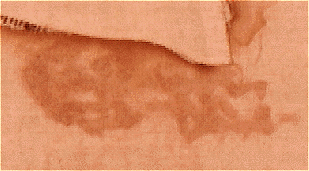
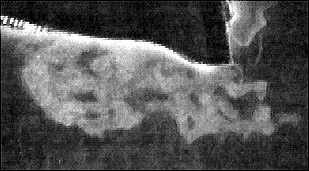
Blood flow from spear wound... wound is at left end of blood stain in this photo. Negative
(positive image, negative blood) photo on the right.
All Photographs - Barrie M. Schworz
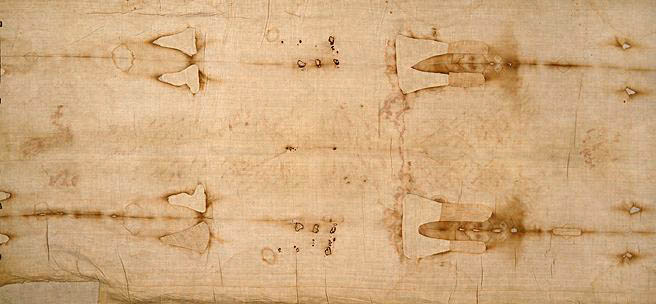
Each of the scourge marks on the back (over 120 of them) have blood and clotted blood in the
wound areas. Note also the blood stains at the nape of the neck and up to the crown of the head.
You can also see the flow of blood across the small of the back from the spear wound in the front.
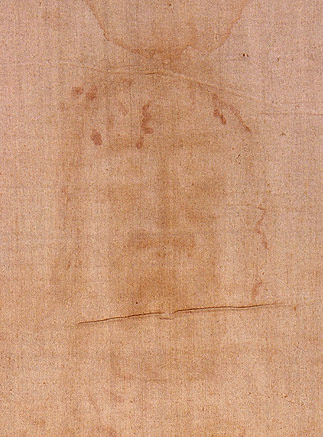
The face on the Shroud... note the blood flows in
the scalp and in the hair.
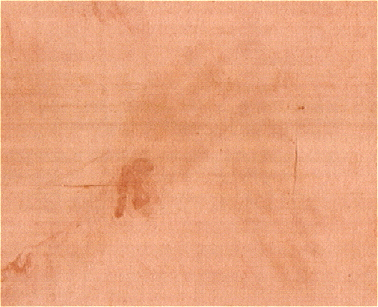
Wrist wound with blood flows. The wound in the wrist
has blood flows from it and down both arms.
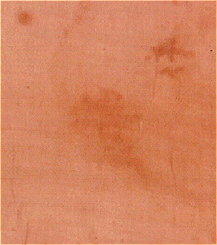
There is blood on the feet from
the wounds there.
Forensic Pathologists have confirmed the blood flows are typical of blood. The plasma is invisible in normal light but the flow of blood from the side wound is surrounded by a serum halo that is obvious under ultra-violet light.
. . . chemist Dr. Alan Adler and biophysicist Dr. John Heller, experts on blood and blood fractions, who state categorically in peer-reviewed scientific Journals, that the blood stains consist of hemoglobin and its derivatives. Aside from light microscopy, Heller and Adler tested for hemochromagen (positive), cyanmethemoglobin (positive), bile pigment bilirubin (positive), and proteolytic enzymes (positive), human specific protein albumin (positive), presence of serum halos around stains (positive), and immunological determination that the blood is of primate origin.
Yale University's Dr. Joseph Gall's spectrophotometer tests showed the blood stains on the Shroud absorb light at 410 nanometers... a test that he states is "specific" for blood, as "nothing in nature that absorbs light at four hundred ten nanometers that strongly".
Dr. Bruce Cameron, whose "double doctorate is dedicated to hemoglobin in all its many forms", on blind review of the test results (i.e., not knowing where the samples came from) stated "You both should know what it is. It's old acid met-hemoglobin." (a remnant compound of aged blood.)
Ergo, according to some of the world's top experts on blood, the blood stains on the Shroud of Turin, are exactly that... blood stains.
As to hair, there have been many hairs removed from the Shroud... but after 700 or 2000 years, whatever the provenance, there is no way of determining whose hair they are. The hair and other contaminants taken from the sticky tapes were catalogued but seem to have no pattern or significance. There are human and animal hairs, of various colors, and patterns.
Too many people have handled the shroud and/or hovered over it, merely looking at it, dropping dandruff, hair, and other detritus for that kind of evidence to have much importance. The reason the pollen has importance (if it is supported in further studies because Max Frei's work has, fairly or unfairly, been called into question) is that the Shroud has never been to the area the observed pollens come from in its 700 years of documented history.
To: Swordmaker
37
posted on
03/22/2005 10:17:09 AM PST
by
Havoc
(Reagan was right and so was McKinley. Down with free trade. Hang the traitors high)
To: Havoc; shroudie; NYer
Color me unconvinced. You questioned "Where is the blood" and I provided proof that the Shroud is rife with blood and serum stains... proof from people who are qualified to make that determination... yet you are "unconvinced." Based on what? Do you doubt the conclusions of chemical and physical tests that would be accepted in any court in the land as completely definitive? Or do you believe these scientists, some of whom worked on samples unaware of their source, "fudged" their results to get the answers they wanted?
If World renowned scientists whose specialties are blood and its descendant compounds are convinced the stains on the Shroud are blood, AND the work has been published in peer-reviewed scientific journals and met the scrutiny of other scientists in the fields, why should anyone doubt it?
Color you unwilling to follow and accept the scientific research. Color you with a closed mind on the subject.
To: Swordmaker
No, just color me unconvinced. How convincing were the Ignatius writings before half of them were later proven frauds. The scientists don't have to be the creators of fraud. Nor do their conclusions that there is blood present prove it's Christ's blood, much less how it got there and why.
Christ definitely lived, died and ascended. Of that I have no doubt. This is just one more suspicious token in a long historical line of them.
39
posted on
03/22/2005 1:09:48 PM PST
by
Havoc
(Reagan was right and so was McKinley. Down with free trade. Hang the traitors high)
To: Havoc
The scientists don't have to be the creators of fraud. Nor do their conclusions that there is blood present prove it's Christ's blood, much less how it got there and why. Sorry. You claimed there was no blood. There is. You declared the Shroud a "fraud" lacking information or based on misinformation. Your basis for making such a determination was flawed.
Can anyone "prove" the Shroud is that of Jesus Christ? Only Jesus Himself. The preponderance of the evidence is the only thing that can indicate... but that is only a preponderance.... it is not, nor can it be, a certainty. There are "scholars" today who are undertaking to convince people that the New Testament is a "Fraud"... just read some of the nosepicking of the Jesus Project people like John Dominic Crossen who have arrogated to themselves the task of deciding what Jesus said and didn't say as reported in the Gospels. Crossen has declared that Jesus would not have been buried and most likely his body was cast into a ditch to be eaten by carrion seekers, never mind what the Bible says. All that, they say, is just pious fiction that later editors added to make it all more mysterious.
Navigation: use the links below to view more comments.
first previous 1-20, 21-40, 41-45 next last
Disclaimer:
Opinions posted on Free Republic are those of the individual
posters and do not necessarily represent the opinion of Free Republic or its
management. All materials posted herein are protected by copyright law and the
exemption for fair use of copyrighted works.
FreeRepublic.com is powered by software copyright 2000-2008 John Robinson





